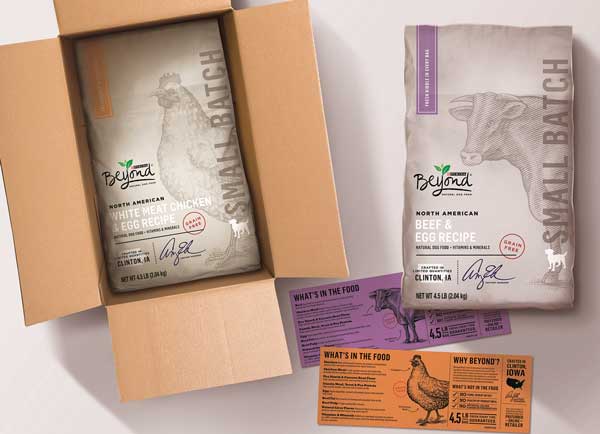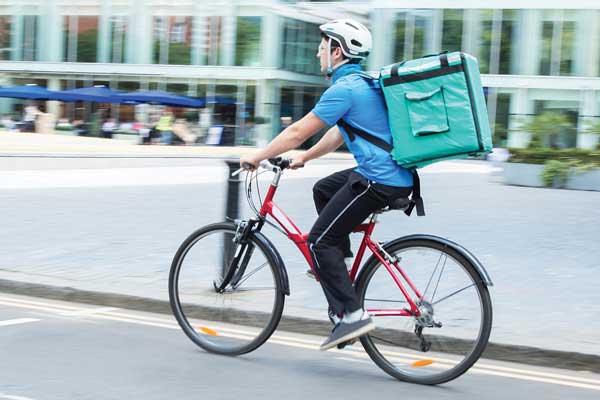E-Commerce Packaging Demands Efficiency
PACKAGING
Both online and brick-and-mortar stores are focused on meeting consumer needs. Online retailers are expected to capture 20% of the grocery market by 2025. Consumers seeking more variety, an in-home shopping experience, and the convenience of delivery are increasingly obtaining food via e-commerce. E-commerce offers consumer access to unique packaged food products and innovative package design for potentially more sustainable food packaging. E-commerce represents a focused opportunity for entrepreneurs and established brands to engage more deeply and individually with consumers in their homes. As urbanization continues, the efficiency of a blended online and physical store format will increase. There is thus an opportunity to engineer more sustainable e-commerce packaging when a value chain perspective is used and to meet the needs of consumers.
Fresh Food and Personalization
E-commerce is most prevalent in China, where 33% of food purchases are made online over more than 4,000 e-commerce platforms. The 60% growth in fresh food e-commerce in China is due primarily to high consumer interest in purchasing dairy, fruits, and vegetables online. Despite the challenges of cold chain logistics, China’s largest online food retailer, JD, provides one-hour delivery of fresh foods and groceries in 22 cities to 30 million customers. Large-scale modified atmosphere chambers as well as modified atmospheres for individual packaging, venting, and time temperature monitoring on packaging play an essential role in ensuring food quality and safety. In China, Hema stores, managed by online retailer Alibaba, provide a blend of local and e-commerce retail that offers personalization with an efficient consumer shopping experience online as well as in-store. In many retail environments, the role of packaging is specific to this new blended environment, and the focus is on quickly getting the right food to consumers. The role of food packaging in providing information is reduced to cost-effectively meet this new format. For example, instead of smart labels and enhanced graphics and information on the actual primary food package, a digital tag the size of a sheet of paper is posted next to the product display in Hema stores. This brings the online format and ordering process into the store. Through a barcode on the screen, shoppers gain access to details such as product origin, certificates of organic authenticity, farm location, and company branding, which would often be found online. This requires less information on the packaging, less printing costs, more common packaging shapes and sizes, and less packaging since products are packaged just before shipping. Consumer information needs are well-met, allowing for fact-based consumer purchases. And the digital screens allow for rapid changes in pricing. The same digital screens are seen online, which 60% of Hema customers use for shopping and delivery. The results are higher efficiency, less consumer packaging, and less food waste.
In this blended retail format, the concept of personalization is obvious. For example, at Alibaba’s Hema store in Beijing, customers are able to order unpackaged fresh food (such as seafood from large water tanks) and have it prepared and cooked for immediate consumption or delivered within a 1.5-mile radius. Milk, meat, and produce are packaged daily, so the focus is on packaging that provides an extended shelf life during bulk distribution rather than a long shelf life. This distinction means that consumers have less packaging to dispose of and that much of the behind-the-scenes packaging can be disposed of properly or reused. This blend of hyper-local and e-commerce delivers personalization and less packaging while reducing food waste. As urbanization continues, the efficiency of this retail blend will increase. Alibaba plans to open 1,000 stores in China by 2023.
 The Purina Beyond product line makes a premium connection to consumers through e-commerce by providing a sustainable package and personalized information. A corrugated recyclable shipping case contains a bag of pet food as well as a note that highlights the signature of the factory manager, depicts where the key ingredient is raised, explains the remaining ingredients, and flags to automate shipments. This personalized approach reinforces the consumer choice and the brand image of a small batch–crafted product that Purina Beyond wishes to convey. This strong brand image is more easily controlled and expressed in the consumer’s home rather than in a crowded pet food aisle. Contract food packaging companies pair shipments to online retailers to reduce the amount of tertiary packaging, and more flexible manufacturing enables corrugated cases of mixed products.
The Purina Beyond product line makes a premium connection to consumers through e-commerce by providing a sustainable package and personalized information. A corrugated recyclable shipping case contains a bag of pet food as well as a note that highlights the signature of the factory manager, depicts where the key ingredient is raised, explains the remaining ingredients, and flags to automate shipments. This personalized approach reinforces the consumer choice and the brand image of a small batch–crafted product that Purina Beyond wishes to convey. This strong brand image is more easily controlled and expressed in the consumer’s home rather than in a crowded pet food aisle. Contract food packaging companies pair shipments to online retailers to reduce the amount of tertiary packaging, and more flexible manufacturing enables corrugated cases of mixed products.
Delivering More
Food delivery is increasing rapidly in urban areas, so packaging has adapted to meet delivery needs. For example, at a two-story Burger King across from the Jokhang temple in Lhasa Tibet, delivery motorcycles respond to a steady stream of orders. In response to the increased demand for food delivery, Lamb Weston has engineered a Crisp on Delivery tray, which enables French fries to remain crisp throughout a 30-minute delivery. The single-serving paperboard-based tray has vents that allow moisture to escape and increase the time that fries remain crisp from six minutes to 30 minutes.
Tamper-evident packaging, reusable packaging, and common packaging are also gaining popularity in food delivery. Keeping food at the proper temperature with tamper-evident packages ensures that consumers receive safe, intact products. Reusable containers for take-away food are not new, but Starbucks customers are incentivized to bring their own mug for a coffee fill-up; this reduces the need for disposable coffee cups. And reusable packaging has usefulness beyond beverages. For example, since 1890, Dabbawalla in Mumbai, India, has distributed hot food in reusable containers daily. However, reusable containers for primary food packaging require proper cleaning prior to reuse. This illustrates how common container sizes for food delivery facilitate ease of delivery as well as accurate sizing so that consumers receive containers that are the right size for food products. Further, use of common sizes for reusable food delivery packaging will allow consumers to return containers to a variety of foodservice venues for washing and reuse.
Delivering perishable items to consumers requires careful product protection to ensure food safety and package sustainability. Shipments of meal kits demonstrate what is currently possible, and research highlights what the future of packaging for perishables could be. Fewer perishable food items are wasted in delivered meal kits than perishable food purchased at brick-and-mortar stores. This is because meat, fruits, and vegetables are selected at the optimum stage for shipping and because ingredients are packaged and portioned to create specific meals for consumers. Both products and packages are optimized for specific distribution. This contrasts with purchasing perishable food products in brick-and-mortar stores, where perishable products are packaged in limited sizes or sold in environments that are not optimal for shelf life. For deliverable meal kits, there is a loose cold chain and the need for a defined shelf life, so package sensors that are often used to ensure product temperatures have not exceeded a temperature range. And reusable shipping containers that regulate carbon dioxide, oxygen, and ethanol levels to maintain produce shelf life may also be used.
 Sustainable E-Commerce Packaging
Sustainable E-Commerce Packaging
The high variance in the size and weight of packaged food and the plethora of combinations in which consumers order packaged food coupled with the complexities of e-commerce logistics seem to justify more packaging. However, when viewed from a value chain perspective, more-sustainable packaging is possible. There are opportunities to use less packaging for e-commerce. This is because most food packaging is optimized for the traditional store environment rather than for e-commerce. By focusing on what the needs of consumers are in their homes, package developers can find cost savings while ensuring food quality and safety. Consumers require instant reinforcement that the e-commerce purchase was the correct decision and minimal packaging that can be sustainably disposed of locally.
Consumer direction on disposal of packaging that links to the local recycling rules are easily provided through the use of quick reference (QR) codes printed on address labels. The QR code links to local recycling regulations via the consumer’s smartphone. Reusable packaging that accommodates refills of concentrated products lends itself to reduced packaging and shipping weight; moreover, the carbon footprints of foods are reduced when products are concentrated within a package. Consumers need only add water to the package headspace above a product. This packaging solution may not be ideal in traditional retail packaging when the product is required to support the package at retail or during shipping.
To further accommodate food delivery, other shifts in packaging are taking place. For example, corrugated trays containing 12 polyethylene terephthalate bottles of salad dressing are stacked up to three pallets high in warehouse environments and shipped to traditional retail environments for use as shelf organizers. Since trays are not needed for the e-commerce environment, alternative packaging such as reusable bottle nesting fixtures on pallets are used to allow easy access to bottles. Because e-commerce sites cross-reference consumers’ history and profile with package sizes to enable better shipping, manufacturers are also standardizing packaging to allow for better cube utilization for items commonly ordered by the same consumer.
 Claire Koelsch Sand, PhD, Contributing Editor
Claire Koelsch Sand, PhD, Contributing EditorCEO, Packaging Technology and Research
Adjunct Professor, Michigan State Univ. and California Polytechnic State Univ.
[email protected]
